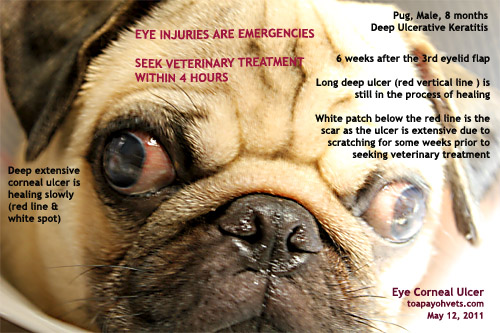Health problems
- Eye infections
- Pug dog encephalitis
- Inflammation of the brain
- Inflammation of the cornea
- Ulcers on the cornea
- Dystocia
Labour stages:
The gestation period for both dogs and cats is for approximately for 60 days. A key sign of parturition is a sudden drop in body temperature by about 1 degree Celsius The body temperature however returns back to normal or increases a little at the time of parturition. Dogs under stress or first time reproducers can delay the delivery of their pups by a day without causing any harm to them. When this happens, there is a temperature drop for the entire period until parturition begins. Labour in cats and dogs can be divided into 3 main stages.
First stage labour:
The first phase of parturition can last in cats and dogs between 6-12 hours. At this time cervical dilation and vaginal constriction takes place, but there is no signs of uterine or abdominal contractions are observed. During this phase, a behavioral change is observed and the bitch is often found to get restless, nesting, panting and licking her vagina now and then.
Second stage labour:
The second stage of labour last between 3 to 12 hours. It can sometimes even extend to 24 hours depending on the litter size. The average litter size for most dogs and cats is between 5 to 8 neonates. The time period between each neonate varies between 15 minutes to 6 hours, though one hour is more common as well as normal. Once a fetus is born, it should take anywhere between 5 minutes to 2 hours before the next is delivered. A time duration of more than 4 hours is risky and must be addressed. All pups and kittens are born with the amnion (a membrane) around them. Furthermore, most of the pups and kittens are born in cranial presentation with a few born in caudal presentation.
Third stage of labour:
The third stage of labour involves the removal/ expulsion of the placenta. Every pup/kitten is delivered with a placenta. However 2 or more pups born followed by the expulsion of a few placenta is also normal(canine placenta separation). During this phase a darkish green colored fluid is also seen to ooze out. This fluid is called uteroverdin and it originated from the junction between the placenta and the endometrium of the uterus. This fluid is only seen to be expelled during or post delivery, not prior.


No comments:
Post a Comment